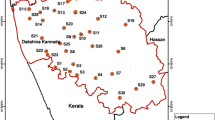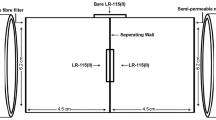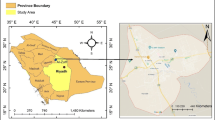Abstract
Alpha track detectors used in a previous investigation of the US National Cancer Institute and the China Ministry of Health on indoor radon (222Rn) in Gansu, China, proved to be influenced by 220Rn (thoron), thus overestimating the 222Rn level. Therefore, the detector was improved used in the previous survey. The new detectors allow discrimination between the two isotopes without any disturbance of the 222Rn measurement. With this detector, a semi-annual study was conducted in 49 traditional dwellings of a village in Gansu. The arithmetic (AM) and geometric (GM) mean 222Rn concentrations were 120 ± 61 and 105 Bq m−3 (with geometric standard deviation GSD = 1.8), respectively, while the mean 220Rn concentrations at 2.5 cm wall distance were 430 ± 210 Bq m−3 (AM) and 350 Bq m−3 (GM) with GSD = 2.3. The high thoron concentrations demonstrate the importance of the 220Rn contribution to radiation exposure, in the investigated area. The actual level of indoor 222Rn was about three times lower than that in the previous investigation which was affected by 220Rn. A correction method for the radon results of the previous study is proposed, which provides 222Rn and 220Rn values comparable with those obtained in the study presented here.





Similar content being viewed by others
References
Lubin JH, Wang ZY, Wang LD, Boice JD Jr, Cui HX, Zhang SR, Conrath S, Xia Y, Shang B, Kleinerman RA (2005) Adjusting lung cancer risks for temporal and spatial variations in radon concentration in dwellings in Gansu province, China. Radiat Res 163:571–579
Tschiersch J, Haninger T (2006) Comments on “Adjusting lung cancer risks for temporal and spatial variations in radon concentrations in dwellings in Gansu Province, China” by Lubin et al. Radiat Res 166:120
Lubin JH, Wang ZY, Boice JD, Wang LD, Boice JD Jr, Cui HX, Zhang SR, Conrath S, Xia Y, Shang B, Kleinerman RA (2006) Response to the letter to the editor by Drs Tschiersch and Haninger. Radiat Res 166:121
Shang B, Iida T, Ikebe Y, Wang Z, Yamada K (1997) Influence of 220Rn on 222Rn measurement in Chinese cave dwellings. In: Katase A, Shimo M (eds) Radon and thoron in the human environment. World Scientific, Singapore, pp 379–384
Yamada Y, Sun Q, Tokonami S, Akiba S, Zhuo W, Hou C, Ishikawa T, Furukawa M, Fukutsu K, Yonehara H (2006) Radon-thoron discriminative measurements in Gansu province, China, and their implication for dose estimates. J Toxicol Env Health A 69:723–734
Wang Z, Lubin JH, Wang LD, Zhang S, Boice JD Jr, Cui HX, Zhang SR, Conrath S, Xia Y, Shang B, Brenner A, Lei S, Metayer C, Cao J, Chen KW, Lei S, Kleinerman RA (2002) Residential radon and lung cancer risk in a high-exposure area of Gansu Province, China. Am J Epidemiol 155:554–564
U.S.-Environmental Protection Agency (1996) Radon Proficiency Program (RPP) handbook, residential measurement and mitigation proficiency. EPA 402-R–95-013, PPE-2
Field RW, Steck DJ, Smith BJ, Brus CP, Neuberger JS, Fisher EF, Platz CE, Robinson RA, Woolson RF, Lynch CF (2000) Residential radon gas exposure and lung cancer: the Iowa radon lung cancer study. Am J Epidemiol 151:1091–1102
Shang B, Cao J, Zhang S, Cui H (2000) Study on 222Rn, 220Rn levels in dwellings of Pingliang area. Chin J Radiol Med Port 20:181–182 (in Chinese)
Wiegand J, Feige S, Quingling X, Schreiber U, Wieditz K, Wittmann C, Xiarong L (2000) Radon and thoron in cave dwellings (Yan’an, China). Health Phys 78:438–444
Shang B, Chen B, Gao Y, Cui H, Li Z (2005) Thoron levels in traditional Chinese residential dwellings. Radiat Environ Biophys 44:193–199
Tschiersch J, Muesch M (2005) Radon exposures in homes: is the contribution of 220Rn (Thoron) to dose always negligible? In: Oeh U, Roth P, Paretzke HG (eds) 9th International conference on health effects of incorporated radionuclides (HEIR 2004). GSF-Bericht 06/05, Neuherberg, pp 214–220
Shang B, Ikebe Y, Iida T (1998) Measurement of radon diffusion coefficients for some filter membranes. In: Proceedings of the 5th Meeting of China Medicine Society Radiology and Radiation Protection (in Chinese)
Guo Q, Iida T, Okamoto K (1995) Measurement of thoron concentration by passive cup method and its application to dose assessment. J Nucl Sci Technol 32:694–796
Ward WJ, Fleischer RL, Mogro CA (1977) Barrier technique separate measurement of radon isotopes. Rev Sci Instrum 48:1440–1441
Nikezic D, Yu KN (2000) LR115 detector response to 222Rn in the presence of 220Rn. Health Phys 78:414–419
Qiu S (2003) Calibration of thoron monitors. Nucl Tech 7:561–563
Tokonami S, Yang ML, Sanada T (2001) Contribution from thoron on the response of passive radon detectors. Health Phys 80:612–615
China EPA (1995) Summary report on the nationwide survey of the natural environmental radiation level in China. China EPA P632 (in Chinese)
Steck DJ, Capistrant JA, Dumm JP, Patton ES (2004) Indoor radon exposure uncertainties caused by temporal variation. In: 11th International Congress of the International Radiation Protection Association (IRPA11), Madrid, Spain
Tokonami S, Sun Q, Akiba S, Zhuo W, Furukawa M, Ishikawa T, Hou C, Zhang S, Narazaki Y, Ohji B, Yonehara H, Yamada Y (2004) Radon and thoron exposures for cave residents in Shanxi and Shaanxi Provinces. Radiat Res 162: 390–396
Tschiersch J, Li WB, Meisenberg O (2007) Increased thoron indoor concentrations and implication to inhalation dosimetry. Radiat Prot Dosim. doi:10.1093/rpd/ncm34110.1093/rpd/ncm341 (in press)
Acknowledgments
We would like to thank Prof. Yukimasa Ikebe and Prof. Takao Iida, Nagoya University, Japan, for their useful help throughout the detector improvement, and Prof. Daniel J. Steck, St. John’s University, USA, for his constructive comments on the manuscript. We also want to thank Ms. Wang Liping and Mr. Chen Tongxing for their field work. This study was partially supported by the National Science Foundation of China, contract 30470530 and 30610103028 (2006).
Author information
Authors and Affiliations
Corresponding author
Rights and permissions
About this article
Cite this article
Shang, B., Tschiersch, J., Cui, H. et al. Radon survey in dwellings of Gansu, China: the influence of thoron and an attempt for correction. Radiat Environ Biophys 47, 367–373 (2008). https://doi.org/10.1007/s00411-008-0163-2
Received:
Accepted:
Published:
Issue Date:
DOI: https://doi.org/10.1007/s00411-008-0163-2




